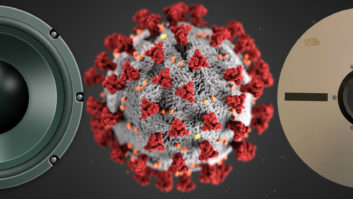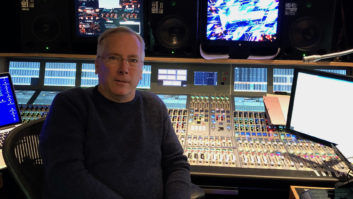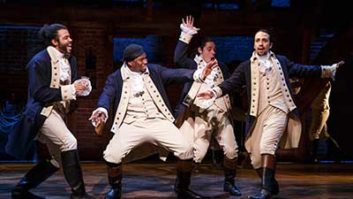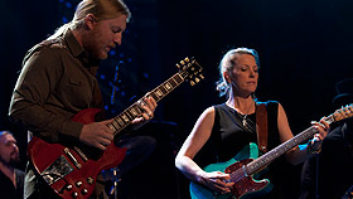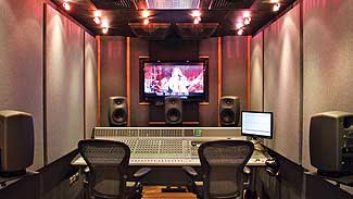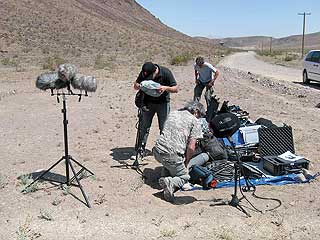
The sound team prepares to record ordnance explosions
Ezra Dweck has been working in post-production for some 18 years now, and he’s amassed quite a résumé for himself. He started his career recording FX at a company called Thunder Tracks, which also included future Hollywood post aces Mark Mangini, Steve Flick and Richard Anderson. That company then became Screaming Lizards and later Weddington Productions. “[Weddington] built a little mix stage,” Dweck recalls, “and I started mixing, and I’ve been a freelance and sometimes staff re-recording mixer ever since — mostly feature films, but also television.” Add to that an occasional credit for FX editing, Foley editing or mixing, even supervising. He continues to mix both features and TV — the past three-plus years he’s juggled work on two hit series, Brothers and Sisters and CSI: New York.
But one of his recent jobs, away from the Hollywood mainstream, has proven to be one of his most interesting and challenging: designing, cutting and mixing the effects for an ultra-sophisticated military Humvee training simulator aimed at protecting U.S. troops from IED (Improvised Explosive Device) bombings and other insurgent attacks. (“Humvee” is actually a loose acronym for HMMWV, or High Mobility Multipurpose Wheeled Vehicle.)
According to Dweck, RL Leaders project executive producer Richard Lindheim and associate producer Bob Wolterstorff — both of whom have TV backgrounds — “were approached by a three-star general who had gotten some intel that said if somebody survived an IED explosion, they were many times more likely to survive the next one. So the general approached Richard about working on this project, and then I got involved. It went through many iterations. Originally, it was just going to be some motion seats in a room, and then it turned into something much bigger” — namely, a customized, engineless Humvee on a motion base in a 60-foot semi-circle surrounded by 260 degrees of large screens onto which is projected a crystal-clear HD image from five Christie projectors at 15,000×1,080 pixels.
The visuals are a Humvee POV as it drives through a setting that looks remarkably like Afghanistan, with rumbly dirt roads, near-desert off-road conditions, small villages, jagged snow-capped peaks in the background and danger clearly lurking nearby. It was shot at a place called Lone Pine, a desolate area between Fresno and Death Valley in east-central California. “You’re driving down dirt roads identifying what they call ‘observables’ and ‘signatures,’ looking for the things that have been known to indicate IEDs,” Dweck explains. “There’s going to be a guy behind the curtain — an observer/controller who will be communicating with the guys in the Humvee. If they get it right, he can branch them off to a safe path; if they get it wrong, he can blow them up at any time or send them down other more difficult paths. In all, there are about a dozen different scenes with different branch points.”
The Audio Challenge
For the sound design, Dweck was tasked with coming up with as realistic a presentation of the sound inside a Humvee in patrol and combat situations as possible. The training Humvee will have five soldiers in it — four in the cramped main part of the vehicle, and one turret gunner on top partially exposed through the roof. “My initial idea was to investigate some 360-degree surround speaker systems, but they just weren’t feasible for the space inside the Humvee,” says Dweck. “I went through a lot of negotiations with the guys who are building the thing — a company called Technifex that does a lot of theme park stuff — and what I wound up with basically is 6.1, but not in a traditional layout inside the vehicle. So it’s five speakers in a normal L/C/R, Ls/Rs position, and then there’s a full-range, full-sized speaker mounted in the dash in the middle and a subwoofer in the engine bay where the engine would be. I did a bunch of research to find a full-performance, relatively small driver speaker I thought would work, and I wound up with a Meyer MM4XP for the five. It’s about the size of a 4-inch tile, but about six inches deep. They run on a 48-volt distribution system, but they’re self-powered. They’re good down to about 300 Hz, so I need the full-sized midrange speaker in the middle to kind of balance it out.
“Then on the exterior, mounted on this giant truss that the projectors are mounted on, I also have three speakers [JBL EONs] arranged left-center-right.”

A computer mock-up of the Humvee training simulator
To get the sort of sounds he needed for the project, Dweck made several trips to the Army’s national training center in California’s Mojave Desert, a facility that’s often used by Hollywood sound crews to capture ordnance and vehicle recordings under military supervision. For the interior sounds of what is formally known as an M-1151 Up-Armored Humvee, “I spent a lot of time in Humvees, bouncing around with military personnel. I’ve done a lot of vehicle recording in my years — what some of us call ‘auto Foley’ — so I had a pretty good idea of what I needed to get to make a usable kit out of my recording. I went out with a military driver. They have a couple of interesting, intense off-road courses with 20-foot-high berms that you can drive up and down — we did several laps on those.
“For the interior, I used an 8-channel Holophone mic, which is like a bunch of DPAs in this big ball; it’s quite a nice mic. I used five of those channels out of the possible eight. Then there’s a guy who’s poked out of the gunner turret, so I knew it was important for me to get some exterior sounds for those three exterior speakers. For that, I used a Neumann 190 [stereo shotgun] single point M/S mic in M/S mode, which I stuck basically where the 50-cal [gun] goes to get some stereo exterior recordings. Then, for the last of the eight channels on my Sound Devices 788, I stuck a lavalier in some of the armor right near the tail pipe. So I ended up with a whole bunch of coincident 8-channel recordings of the Humvee, shot 24-bit.”
For the ordnance recordings, Dweck had help from some of his film sound colleagues: Mark Mangini, Jon Fasal and Charlie Campagna. For the massive main IED explosion, Army EOD (Explosive Ordnance Disposal) personnel used several pounds of C4 to detonate a 120mm tank shell in a dry creek bed as Dweck and company captured the sound from numerous mics ranging from 100 to 1,000 feet away. Dweck, with a Sound Devices 744 and [Crown] SASS-B with B&K 4006 omnis and Neumann 190 in Stereo mode — was the farthest away (and put mics inside a van for that muted sound); Mangini used a 788, his custom Schoeps setup and a Holophone; Fasal had a 788 and various dynamics and condensers, which he changed for each explosion; and Campagna’s rig was an 8-channel Deva with several different dynamics and condensers, and some PZMs.
The Army let Dweck and a couple of his team members record AK-47s firing several hundred rounds — he amassed 20 tracks of that. Dweck also recorded some simulated radio communications “chatter” over secure military radios, tracked directly to Pro Tools LE on a laptop. That chatter is heard on two channels inside the Humvee training setup.
Not the Usual Post Process
“When we were done, I brought it all back, put it up on Pro Tools and started weeding out and mastering it,” he says. “I used a little compression on some things, but I was trying not to use too many Hollywood tricks on any of this stuff. Through the whole project, I had to keep telling myself, ‘Verité, verité, verité!’ Those guys who are going to sit in the Humvee know how they sound, so it was really important that it was accurate and they weren’t instead paying attention to, ‘Wow, what neat sound effects!’” In fact, Dweck learned early on that the sound inside a Humvee when an IED blasts outside is fairly muffled, so the more pure explosion sounds would be heard primarily just on the exterior speakers, where the gunner hears most clearly.
Next, Dweck and Aaron Glascock (another top Hollywood mixer and supervisor) cut the FX, which ran the gamut from engine idles to a sandstorm and various winds, to ordnance fire and even simulated tinnitus effects for the chaotic first minutes after an IED explosion. Dweck did a rough mix of the material in one of the brand-new Pro Tools/D-Control “Concept” rooms at Warner Bros., got some feedback from his producers and then did the final mix (also at Warner Bros.) on the speakers that were to be mounted in the Humvee. “I would like to mention how incredibly helpful Warner Bros. was with this project,” Dweck says, “especially Kim Waugh, Bill Angorola and the engineering staff.”
Of course, sound is just one part of this amazing simulation apparatus. The six-piston motion platform on which the altered Humvee sits can generate up to five Gs of acceleration and reproduce the bumps and hills shown in the HD video. Also, when an IED “explodes” under the Humvee, Dweck says, “a gas-powered pneumatic ram hits the bottom of the thing — it’s a helluva kick! — while a propane-powered concussive device called a bird cannon produces a 140dB bang.”
For the final mix in the actual simulator, Dweck rented a Pro Tools HD rig from Absolute Rentals. “We figured out how to get a ProControl main unit and one fader pack wedged between the two front seats of the Humvee, which was mounted on the motion base about seven feet up in the air. I had to climb in and out with a ladder. I jammed my 6-foot body into the back sitting on the transmission hump. The inside of a Humvee is a little torture palace, with large exposed bolts and brackets everywhere. I can’t count the number of times I hit my head, and I couldn’t sit up straight.
“It was without question the most uncomfortable mix room I’ve ever worked in. I would mix a scene, get out and stretch, and then grab Bob Wolterstorff and Richard Lindheim for a playback; they’d sit in the back seats directly next to me, we’d make some tweaks, they’d climb out and I’d move on to the next scene. The proof came when we started putting all the elements together — the mix plays exactly as we expected it to when the motion profiles are applied.”
Asked whether, ultimately, he feels like he’s doing a good deed by taking on this sort of project, Dweck notes, “You know, I’ve spent years sitting there at two o’clock in the morning replacing and removing inconsequential dog barks for the fourth time at the whim of some producer — which is my job and I’m glad to do it. But I’ve looked at my co-workers, and said, ‘You know, we’re really not saving lives here, guys.’ This is the first time I’ve been involved in something where I actually might have some effect on somebody’s life. If I can make this real enough and help a guy learn to spot something and avoid it, or help them learn how to make a direct hit more survivable because they’ve been through something like it once, that’s huge. That’s bigger than all my past credits put together.”
